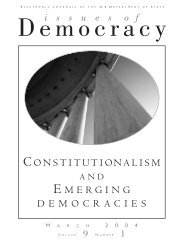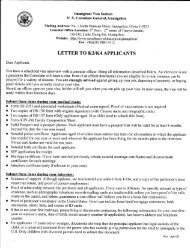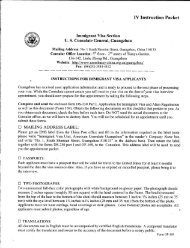s. history us history us history - Embassy of the United States
s. history us history us history - Embassy of the United States
s. history us history us history - Embassy of the United States
- No tags were found...
You also want an ePaper? Increase the reach of your titles
YUMPU automatically turns print PDFs into web optimized ePapers that Google loves.
CHAPTER 6: SECTIONAL CONFLICTOUTLINE OF U.S. HISTORYshould be accomplished by legal andpeaceful means. Garrison was joinedby ano<strong>the</strong>r powerful voice, that <strong>of</strong>Frederick Douglass, an escaped slavewho galvanized Nor<strong>the</strong>rn audiences.Theodore Dwight Weld and manyo<strong>the</strong>r abolitionists cr<strong>us</strong>aded againstslavery in <strong>the</strong> states <strong>of</strong> <strong>the</strong> old NorthwestTerritory with evangelical zeal.One activity <strong>of</strong> <strong>the</strong> movement involvedhelping slaves escape to saferefuges in <strong>the</strong> North or over <strong>the</strong> borderinto Canada. The “UndergroundRailroad,” an elaborate network <strong>of</strong>secret routes, was firmly establishedin <strong>the</strong> 1830s in all parts <strong>of</strong> <strong>the</strong> North.In Ohio alone, from 1830 to 1860, asmany as 40,000 fugitive slaves werehelped to freedom. The number <strong>of</strong>local antislavery societies increasedat such a rate that by 1838 <strong>the</strong>re wereabout 1,350 with a membership <strong>of</strong>perhaps 250,000.Most Nor<strong>the</strong>rners none<strong>the</strong>less ei<strong>the</strong>rheld <strong>the</strong>mselves alo<strong>of</strong> from <strong>the</strong>abolitionist movement or activelyopposed it. In 1837, for example, amob attacked and killed <strong>the</strong> antislaveryeditor Elijah P. Lovejoy inAlton, Illinois. Still, Sou<strong>the</strong>rn repression<strong>of</strong> free speech allowed <strong>the</strong>abolitionists to link <strong>the</strong> slavery issuewith <strong>the</strong> ca<strong>us</strong>e <strong>of</strong> civil libertiesfor whites. In 1835 an angry mobdestroyed abolitionist literature in<strong>the</strong> Charleston, South Carolina, post<strong>of</strong>fice. When <strong>the</strong> postmaster-generalstated he would not enforce delivery<strong>of</strong> abolitionist material, bitter debatesensued in Congress. Abolitionistsflooded Congress with petitionscalling for action against slavery. In1836 <strong>the</strong> Ho<strong>us</strong>e voted to table suchpetitions automatically, th<strong>us</strong> effectivelykilling <strong>the</strong>m. Former PresidentJohn Quincy Adams, elected to <strong>the</strong>Ho<strong>us</strong>e <strong>of</strong> Representatives in 1830,fought this so-called gag rule as aviolation <strong>of</strong> <strong>the</strong> First Amendment,finally winning its repeal in 1844.TEXAS AND WAR WITHMEXICOThroughout <strong>the</strong> 1820s, Americanssettled in <strong>the</strong> vast territory <strong>of</strong>Texas, <strong>of</strong>ten with land grants from<strong>the</strong> Mexican government. However,<strong>the</strong>ir numbers soon alarmed <strong>the</strong>authorities, who prohibited fur<strong>the</strong>rimmigration in 1830. In 1834 GeneralAntonio López de Santa Annaestablished a dictatorship in Mexico,and <strong>the</strong> following year Texansrevolted. Santa Anna defeated <strong>the</strong>American rebels at <strong>the</strong> celebratedsiege <strong>of</strong> <strong>the</strong> Alamo in early 1836,but Texans under Sam Ho<strong>us</strong>tondestroyed <strong>the</strong> Mexican Army andcaptured Santa Anna a month laterat <strong>the</strong> Battle <strong>of</strong> San Jacinto, ensuringTexan independence.For almost a decade, Texas remainedan independent republic,largely beca<strong>us</strong>e its annexation as ahuge new slave state would disrupt<strong>the</strong> increasingly precario<strong>us</strong> balance<strong>of</strong> political power in <strong>the</strong> <strong>United</strong><strong>States</strong>. In 1845, President James K.Polk, narrowly elected on a platform<strong>of</strong> westward expansion, brought <strong>the</strong>Republic <strong>of</strong> Texas into <strong>the</strong> Union.Polk’s move was <strong>the</strong> first gambit ina larger design. Texas claimed thatits border with Mexico was <strong>the</strong> RioGrande; Mexico argued that <strong>the</strong>border stood far to <strong>the</strong> north along<strong>the</strong> Nueces River. Meanwhile, settlerswere flooding into <strong>the</strong> territories<strong>of</strong> New Mexico and California.Many Americans claimed that <strong>the</strong><strong>United</strong> <strong>States</strong> had a “manifest destiny”to expand westward to <strong>the</strong>Pacific Ocean.U.S. attempts to purchase fromMexico <strong>the</strong> New Mexico and Californiaterritories failed. In 1846,after a clash <strong>of</strong> Mexican and U.S.troops along <strong>the</strong> Rio Grande, <strong>the</strong><strong>United</strong> <strong>States</strong> declared war. Americantroops occupied <strong>the</strong> lightlypopulated territory <strong>of</strong> New Mexico,<strong>the</strong>n supported a revolt <strong>of</strong> settlersin California. A U.S. force underZachary Taylor invaded Mexico,winning victories at Monterrey andBuena Vista, but failing to bring <strong>the</strong>Mexicans to <strong>the</strong> negotiating table. InMarch 1847, a U.S. Army commandedby Winfield Scott landed nearVeracruz on Mexico’s east coast, andfought its way to Mexico City. The<strong>United</strong> <strong>States</strong> dictated <strong>the</strong> Treaty<strong>of</strong> Guadalupe Hidalgo in whichMexico ceded what would become<strong>the</strong> American Southwest region andCalifornia for $15 million.The war was a training groundfor American <strong>of</strong>ficers who wouldlater fight on both sides in <strong>the</strong> CivilWar. It was also politically divisive.Polk, in a simultaneo<strong>us</strong> facedownwith Great Britain, had achievedBritish recognition <strong>of</strong> Americansovereignty in <strong>the</strong> Pacific Northwestto <strong>the</strong> 49th parallel. Still, antislaveryforces, mainly among <strong>the</strong> Whigs,attacked Polk’s expansion as a proslaveryplot.With <strong>the</strong> concl<strong>us</strong>ion <strong>of</strong> <strong>the</strong> MexicanWar, <strong>the</strong> <strong>United</strong> <strong>States</strong> gaineda vast new territory <strong>of</strong> 1.36 millionsquare kilometers encompassing <strong>the</strong>present-day states <strong>of</strong> New Mexico,Nevada, California, Utah, most <strong>of</strong>Arizona, and portions <strong>of</strong> Coloradoand Wyoming. The nation als<strong>of</strong>aced a revival <strong>of</strong> <strong>the</strong> most explosivequestion in American politics <strong>of</strong> <strong>the</strong>time: Would <strong>the</strong> new territories beslave or free?THE COMPROMISE OF 1850Until 1845, it had seemed likelythat slavery would be confined to <strong>the</strong>areas where it already existed. It hadbeen given limits by <strong>the</strong> MissouriCompromise in 1820 and had no opportunityto overstep <strong>the</strong>m. The newterritories made renewed expansion<strong>of</strong> slavery a real likelihood.Many Nor<strong>the</strong>rners believed thatif not allowed to spread, slaverywould ultimately decline and die.To j<strong>us</strong>tify <strong>the</strong>ir opposition to addingnew slave states, <strong>the</strong>y pointed to <strong>the</strong>statements <strong>of</strong> Washington and Jefferson,and to <strong>the</strong> Ordinance <strong>of</strong> 1787,which forbade <strong>the</strong> extension <strong>of</strong> slaveryinto <strong>the</strong> Northwest. Texas, whichalready permitted slavery, naturallyentered <strong>the</strong> Union as a slave state.But <strong>the</strong> California, New Mexico,and Utah territories did not haveslavery. From <strong>the</strong> beginning, <strong>the</strong>rewere strongly conflicting opinionson whe<strong>the</strong>r <strong>the</strong>y should.134135












